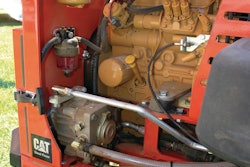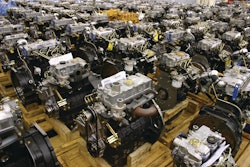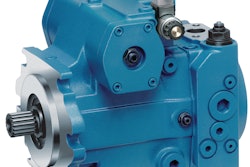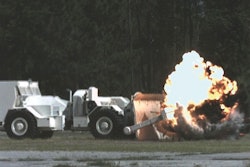Anything that gives contractors a timesaving edge puts money in their pockets. That's why when compact excavator users requested a way to change attachments quickly and with less effort, Bobcat Co., a business of Ingersoll Rand, listened. The response was the recently released Hydraulic X-Change mounting system for Bobcat compact excavator models 337, 341 and 435.
"We watch customers work with buckets, breakers, augers, compactors and grapples, and we listen to what they say," explains Tom Connor, excavator product specialist for North America. "There have been mechanical quick attaches since the late '90s for excavators in the 4- to 5-ton range. When some customers change attachments 10 times a day, the bar gets raised and they ask for a better system."
If those customers also operate large excavators or use Bobcat skid steer and track loaders, they've experienced hydraulic quick-attach systems. "They've used these ‘quick-tachs' and wanted them for compact excavators," Connor says.
In addition to customer requests, Bobcat wanted to help contractors use the best attachment for the job. "We've witnessed operators dig a footer with a large bucket when a smaller 12- or 13-inch bucket would work better," he recalls. "When asked why, they tell us it was too much work to change buckets."
A glimpse at the future
Bobcat developed a hydraulic quick-tach mounting system and gave people a sneak peak at it at the ICUEE show in 2005. What kind of reaction did it receive?
"It went over really well, so well that they started calling our dealers and the company to ask for it," Connor admits. "They liked the idea that operators wouldn't have to manually position or align attachment pins during hook-up.
"We did so with a unique design that's incorporated in the Hydraulic X-Change," he says. "It was released to production in September '06 as an option on new 337, 341 and 435 compact excavators as well as a dealer-installed retrofit accessory. It's this size machine where customers would likely use multiple attachments, and those attachments are heavy enough to require two people to move into place."
A closer look at the system
There are two key components in the new system. One is the hydraulic control circuit that retracts pins to remove an attachment and extend to secure another one.
"For operator ease, we designed a circuit solely for the mounting system," Connor explains, "which is unique to the industry. It doesn't divert oil from another existing function, so the operator doesn't have to stop one action to activate the quick-tach."
In addition to the dedicated circuit, there was the challenge of creating the X-Change body itself. "We had to design an arrangement that would ‘live' in a tough environment," he says. "We would take oil from the machine to a very small, confined component that works down in the dirt and withstand impact from rocks. It also had to handle a continuous 185-degree range of motion as the machine cycles."
The typical hydraulic hose wouldn't last in such an environment, so Bobcat opted for a swivel joint. "It could absorb some of the stresses that range of motion causes much better than a hose," Connor notes. "If there are two things our customers want to avoid, they'd be downtime to replace hoses and clean up hydraulic fluid leaks."
Operator simplicity was another design criteria. "We wanted to make it as simple as possible for operators," he emphasizes. "We did that by means of a rocker switch on the dash. It clearly locks or unlocks the attachment and doesn't affect any other function."
Another benefit of the new design is its size. "The system is small and maintains the original ‘pin-on' attachment geometry, so the user maintains the breakout forces of the machines' arm and attachment," Connor points out. "Other systems are inserted between the arm and the attachment so they can shift the bucket down 4 to 5 inches. This means the operator loses the mechanic advantage of the attachment's and arm's prying force. The bucket pivot-to-tooth measurement also remains the same, so it won't interfere with other functions."
Another feature of the system is its hook and ear arrangement. "As the attachment is released, it only falls about an inch and a half," he explains, "to be retained by the ears. Then the operator can easily roll the attachment out, place it on the ground and complete the change-out. This ensures the operator retains full control of the attachment."
A good ROI
Connor says the option adds less than 2.5% of the machine's cost to its price. Contractors can easily recoup that investment in the first season, he claims.
"The Hydraulic X-Change mounting system can save operator time, fatigue and labor," he notes. "It encourages operators to use the best attachment for the job at hand, as well. This can reduce contractor costs. For example, if a footing hole is dug larger than needed because the operator doesn't want to change buckets, that hole then requires extra concrete or fill material, costs which the contractor has to absorb."



















